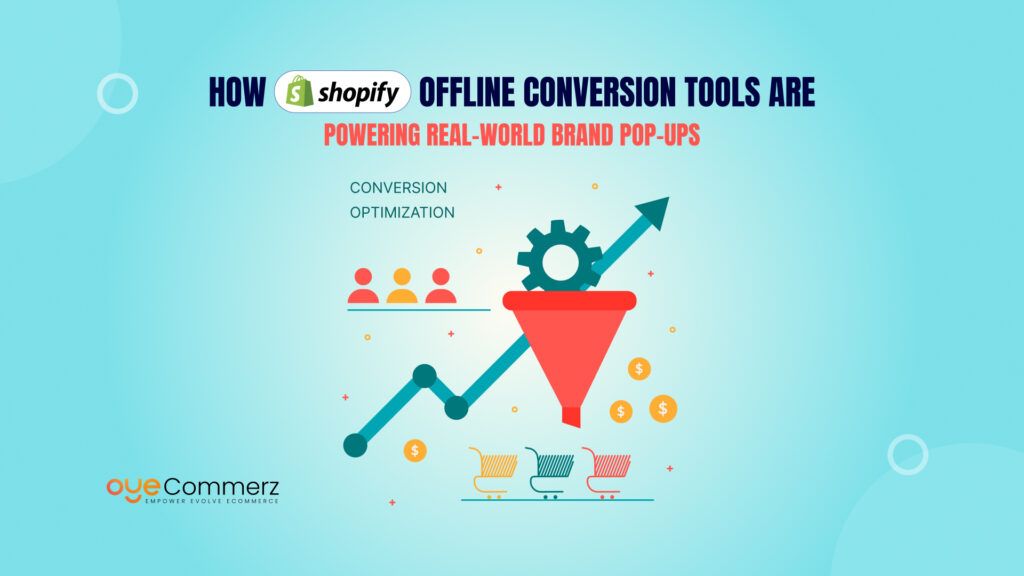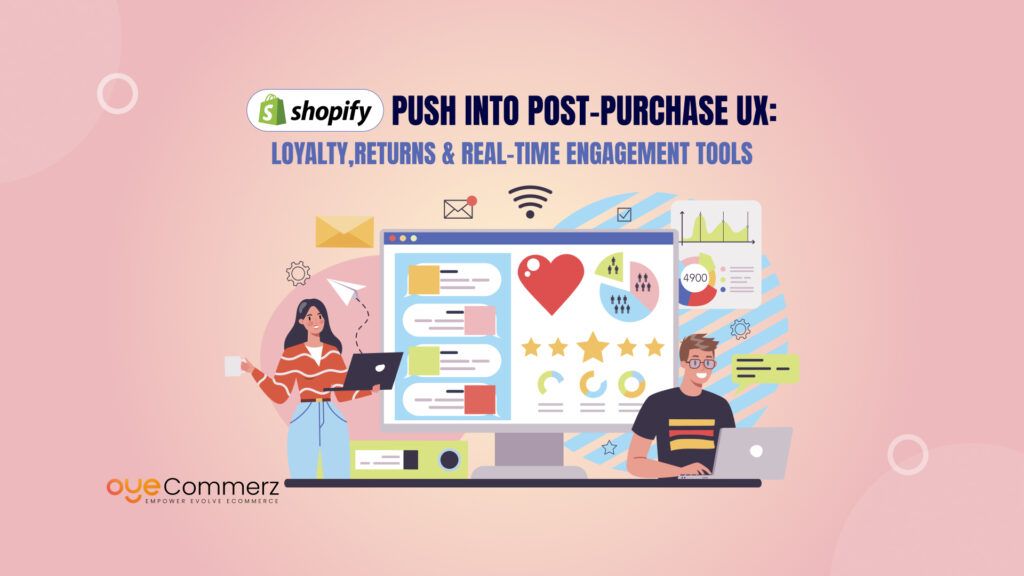According to Statista, e-commerce platforms using gamification see a 47% boost in engagement and up to 22% higher conversion rates. These numbers prove that gamified experiences in e-commerce aren’t just trendy, they’re effective. But for Shopify merchants, adding game-like features can be tricky. Go too far, and you risk frustrating serious shoppers. Stay too safe, and you miss out on valuable engagement.
This guide is built to help Shopify sellers strike the right balance.
By using Shopify gamification tools and smart customer engagement strategies, you can create interactive features that boost user retention, reduce bounce rates, and increase lifetime value (LTV), all while keeping the shopping experience smooth and professional.
We’ll explore practical methods to enhance e-commerce UX with game mechanics and Shopify services, helping you stand out in a crowded market without turning away your loyal customers.
The Evolution of E-Commerce and the Need for Gamified Experiences
The e-commerce landscape has changed dramatically. We’ve moved from basic transactional websites to dynamic, experience-driven platforms. This shift demands more than just attractive pricing or fast delivery, it requires deep engagement.
Today, online stores are everywhere. With thousands of brands vying for the same customer, shoppers often feel overwhelmed. As a result, businesses struggle to retain attention and build loyalty.
Diminishing User Attention and Loyalty
Shoppers now expect more than scrolling and clicking. Without interactivity, your Shopify store becomes just another tab to close.
Poor UX Hurts Performance
A static user experience often leads to:
- Higher bounce rates
- Lower session times
- Increased cart abandonment
- Fewer return visits
These aren’t just technical issues, they directly impact your store’s revenue and growth potential.
Smart Gamification Drives Engagement
By adding gamified layers like quizzes, scratch cards, or time-bound rewards, you can turn passive browsing into active participation.
Gamification gives users a reason to stay longer and return more often. It also offers real-time incentives that help increase order value and reduce friction in the customer journey.
For Shopify users, the ecosystem supports a wide range of Shopify services and gamification plugins that can be implemented without coding, making it easier than ever to experiment and scale.
Gamification Opportunity Table
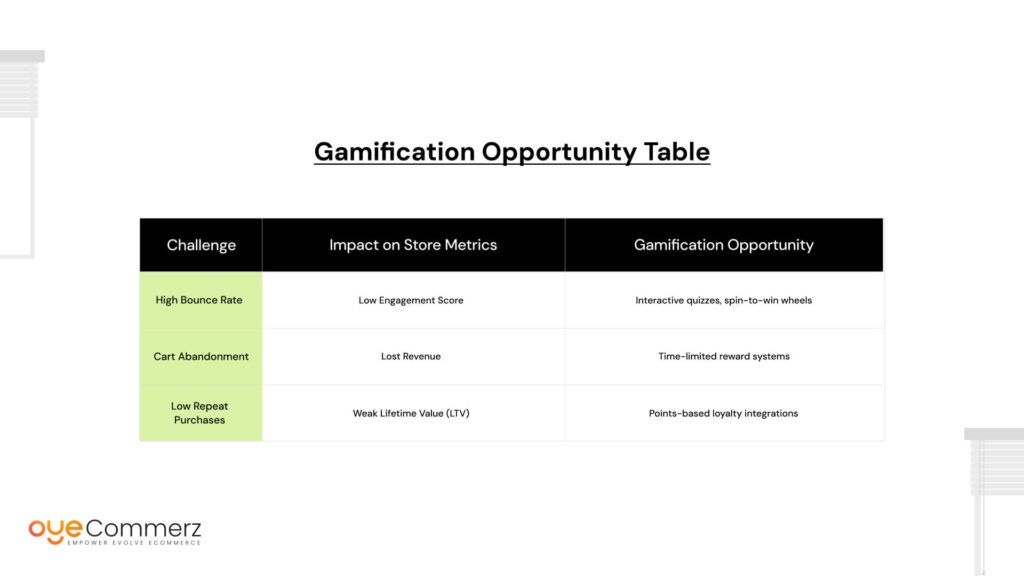
Gamified experiences in e-commerce aren’t gimmicks, they’re modern UX tools that solve real business problems.
Understanding Gamified Experiences in E-Commerce
Gamified experiences in e-commerce refer to the integration of game-like elements into online shopping platforms. This doesn’t mean turning your store into a video game. Instead, it involves using gaming principles, such as challenges, rewards, and progress tracking, to enhance the customer journey.
The goal? Engage shoppers, boost conversions, and build loyalty, without disrupting the flow of a serious buyer.
What Gamification Is (and Isn’t)
Gamified experiences aren’t full-fledged games. Instead, they include:
- Rules: Clear guidelines for actions (e.g., “Earn 10 points for every $1 spent”)
- Feedback: Visual cues like badges, meters, or pop-ups
- Motivation: Rewards, unlockables, and incentives that nudge users forward
These elements create a sense of accomplishment and anticipation, two key emotions that drive repeat behavior.
Examples of Gamification in a Shopify Context
Shopify offers multiple plugins and tools that support gamification, such as:
- Loyalty Apps like Smile.io or Rise.ai that reward repeat customers
- Spin-the-Wheel Widgets for instant coupon wins
- Point-Based Reward Systems to encourage account creation and referrals
These tools integrate seamlessly into your Shopify store, offering non-intrusive, incentive-driven experiences.
Purpose-Driven Design
It’s important to remember that the purpose of gamification isn’t to distract shoppers, but to enhance their experience. Whether it’s guiding them to explore more products or rewarding them for social shares, gamification should align with their goals, not complicate their journey.
When thoughtfully applied, gamification:
- Builds customer trust
- Makes the buying process enjoyable
- Drives meaningful action (sign-ups, purchases, referrals)
Done right, gamified experiences in e-commerce increase brand affinity while keeping the path to purchase clean and intuitive.
Strategic Game Elements That Work for Shopify Stores

Gamification in e-commerce is only effective when it serves a clear purpose, to convert visitors into customers and keep them coming back. While flashy effects may attract clicks, it’s the strategic use of game elements that delivers real business value. For Shopify stores, the right tools are already available to turn shopping into a more engaging, rewarding experience.
Points and Tier Systems: Build Loyalty Over Time
A well-structured points and tiers model gives customers a reason to return.
- Shoppers earn points for every dollar spent, product review, or social share.
- Tier levels (e.g., Bronze, Silver, Gold) offer escalating benefits, exclusive deals, early access to new products, or free shipping.
Apps like Smile.io and LoyaltyLion integrate easily with Shopify, letting you launch full-featured loyalty programs in minutes.
Spin-to-Win Wheels: Convert First-Time Visitors
Spin-to-win popups offer instant gratification.
- They encourage email sign-ups by letting users spin a virtual wheel for discounts.
- Effective for first-time users, this tool captures leads while creating a positive, playful first impression.
Shopify plugins like Wheelio or Privy offer customizable wheels with real-time analytics.
Progress Bars: Nudge Users to Complete Orders
A progress bar during checkout shows users how close they are to unlocking a reward, like free shipping or a gift.
- It encourages larger cart sizes by triggering the completion instinct.
- Best used during the cart or checkout process to increase average order value (AOV).
Quizzes & Product Matchers: Guide Smart Purchases
Product quizzes make shopping interactive while solving a real problem, choice overload.
- Shoppers answer a few questions and receive tailored product suggestions.
- This improves product discovery and reduces bounce.
Shopify tools like Octane AI let merchants build high-converting quizzes without coding.
Gamified Referrals: Encourage Peer Influence
Turn satisfied customers into brand advocates with gamified referral programs.
- Offer both the referrer and referee a reward (points, discount).
- Easy to manage via apps like ReferralCandy or Growave on Shopify.
Avoid Flashy Gimmicks
The goal isn’t to “wow” users with effects, it’s to deliver value.
Keep your gamified features clear, purposeful, and unobtrusive to maintain trust and usability.
Where Gamification Goes Wrong in E-Commerce UX

While gamified experiences in e-commerce can boost engagement and conversions, overdoing it can backfire. Many Shopify stores fall into common traps that turn shoppers away instead of pulling them in.
Overuse Causes Fatigue and Distrust
When gamification elements flood every page, popups, banners, spinning wheels, flashing rewards, it overwhelms users. Instead of feeling excited, shoppers feel pressured or annoyed. This fatigue leads to frustration and can damage your brand’s credibility.
Confusing Interfaces Reduce Conversion
Cluttered, complex game mechanics cause confusion. If users don’t quickly understand what to do or what rewards mean, they lose interest. Poorly designed gamification can slow down the buying process, leading to drop-offs.
A clear, simple user interface is essential to keep conversions high. If the gamification becomes a distraction, it defeats its own purpose.
Loyalty Fatigue: Points Lose Meaning
Many programs suffer from “loyalty fatigue.” Customers accumulate points but don’t see the value or clear ways to redeem them. When points feel like just numbers without rewards, users disengage.
This lack of clarity causes customers to ignore the program entirely, wasting your investment.
Subtle Layering Over Proven UX Practices
The key to avoiding these pitfalls is to layer gamification subtly over existing, proven user experience designs. Gamified features should enhance, not replace, smooth navigation and easy checkout.
- Use gamification to guide shoppers gently, not force interaction.
- Focus on adding value, like exclusive rewards for opting in.
- Ensure your game mechanics are intuitive and relevant.
Opt-In, Don’t Force
An important rule for successful gamified experiences in e-commerce is to make participation optional. Users who choose to engage will be more motivated and positive about their experience.
Forcing popups or mandatory games interrupts the shopping flow and may drive users away. Instead, offer engaging, well-placed invitations to join loyalty programs, spin wheels, or quizzes.
Over-gamification risks user fatigue, confusion, and loss of trust, damaging conversions and brand reputation. Shopify merchants should prioritize a balanced approach that blends gamification thoughtfully into the shopping journey.
By respecting users’ time and preferences, and offering clear value, you can harness the power of gamified experiences in e-commerce without overwhelming your audience.
How to Balance Engagement with Professionalism in Shopify Stores
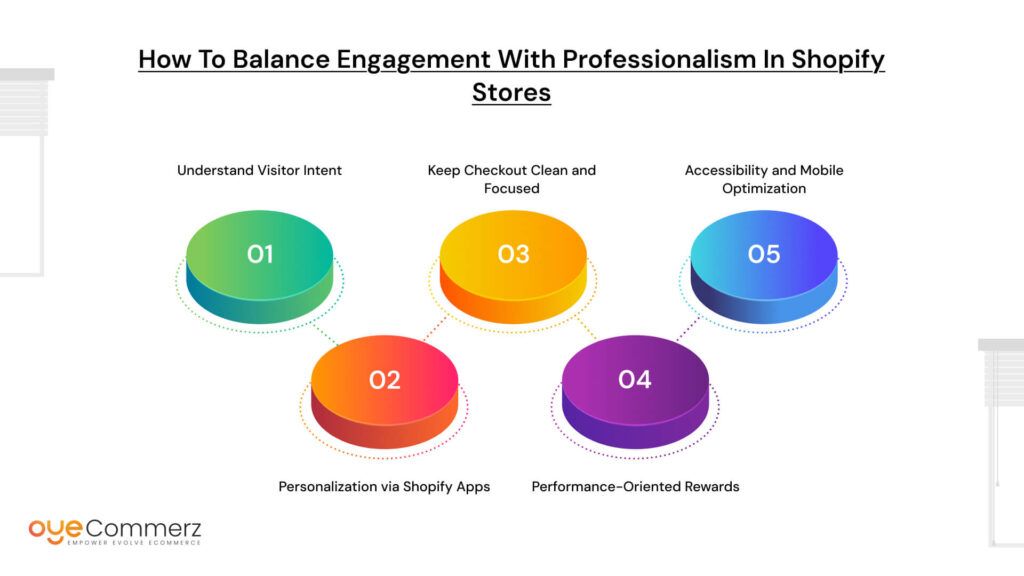
Gamification can elevate the online shopping experience, but not all customers want playful elements. While gamified experiences in e-commerce increase interaction and loyalty, they must be designed carefully to avoid turning away serious or goal-oriented shoppers.
User Segmentation: Understand Visitor Intent
Not every shopper behaves the same. Some are browsers; others are mission-driven. Recognizing this, Shopify merchants should segment users based on behavior and intent. Gamified features can be introduced more heavily to casual users while offering a straightforward experience to purposeful buyers.
Personalization via Shopify Apps
Leverage Shopify-compatible personalization tools to display gamification only to users likely to engage. For instance, returning users who explore multiple products may be open to reward prompts or spin-to-win features. First-time or high-intent visitors, on the other hand, may prefer a clean, frictionless path to checkout.
Tailoring these elements reduces disruption and enhances customer satisfaction.
Keep Checkout Clean and Focused
One golden rule: never interrupt transactional moments. Gamified prompts should not appear during checkout or payment stages. A serious shopper ready to buy can be derailed by unexpected pop-ups, causing frustration or even cart abandonment.
Maintain a clear, distraction-free environment when it counts the most.
Performance-Oriented Rewards
Rather than flashy games, offer rewards tied to real value. For example:
- Points for product reviews
- Discounts for social shares
- Loyalty perks for repeat purchases
These actions encourage deeper brand interaction without feeling childish or gimmicky.
Accessibility and Mobile Optimization
Ensure gamification works seamlessly on all devices and for all users, including those with disabilities. Accessibility should never be compromised. Use clear visuals, readable fonts, and mobile-friendly formats to ensure that gamified features don’t alienate or exclude any group.
Balancing fun with function is key. When used with intent, gamified experiences in e-commerce can boost engagement while still respecting the preferences of your most focused shoppers.
Shopify-Focused Gamification Tactics That Drive Growth
Gamification doesn’t need to be complex or disruptive. With the right apps and integrations, Shopify merchants can implement subtle yet powerful features that boost engagement and drive sales. Here are practical, tested ideas tailored for Shopify stores:
Loyalty Apps to Encourage Repeat Purchases
Loyalty programs are the backbone of effective gamified experiences in e-commerce. Shopify-compatible apps like Smile.io and Yotpo Loyalty offer points-based systems, tiered memberships, and referral rewards. These tools motivate customers to return, spend more, and promote your brand organically.
Spin-to-Win Widgets for First-Time Visitors
Gamified popups like WooHoo and Gameball use spin-to-win mechanics to provide instant gratification. Offering discounts or free shipping through a spinning wheel can turn browsers into buyers, without needing deep customization or development work.
Progress Bars to Drive Cart Completion
Cart abandonment is a major challenge. Adding progress indicators like those from Ultimate Sticky Add to Cart shows how close users are to unlocking perks such as free shipping or bonus items. This subtle cue pushes users to increase cart size.
Post-Purchase Quizzes for Better Personalization
Instead of letting the interaction end at checkout, consider post-purchase engagement. Tools that integrate quizzes with order history can suggest future products, increasing LTV. These quizzes, often integrated with revenue-based suggestion forms, help merchants upsell smartly.
Email Scratch Cards with Klaviyo Integration
Want to keep customers coming back? Send scratch card incentives via email using Klaviyo. These digital scratchers offer random rewards and keep the experience exciting while building a stronger email list.
With these Shopify-specific gamification strategies, you can boost engagement and conversion without overhauling your existing design or store flow.
How to Implement Gamified Experiences on Shopify
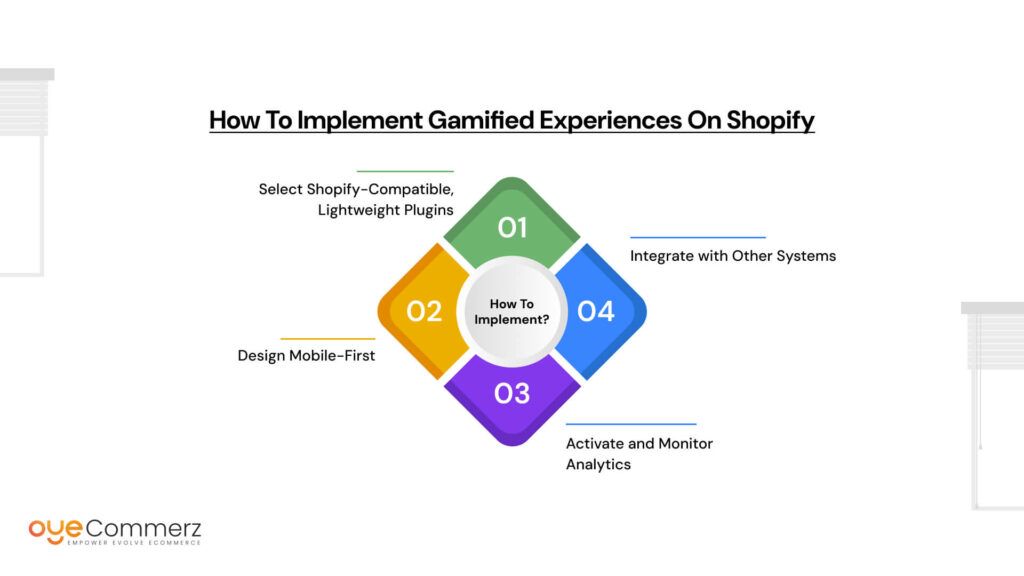
Gamified experiences in e-commerce aren’t just about fun, they require seamless, efficient, and data-driven implementation. For Shopify merchants, technical execution can either enhance or disrupt the shopping journey. Here’s how to ensure your gamified layers drive results without breaking functionality.
1. Select Shopify-Compatible, Lightweight Plugins
Begin with choosing apps specifically designed for Shopify. Ensure they are lightweight and do not slow down your store. Avoid overly JavaScript-heavy tools that could affect page load speed, performance directly impacts conversions and SEO.
Recommended categories:
- Loyalty & Rewards: Smile.io, Rise.ai
- Spin-to-Win & Popups: WooHoo, Privy
- Quiz Builders: Octane AI, RevenueHunt
Choose plugins with high ratings, responsive support, and regular updates to align with Shopify’s evolving ecosystem.
2. Design Mobile-First
A large chunk of e-commerce traffic comes from mobile devices. Ensure all gamified elements, quizzes, wheels, progress bars, are responsive and thumb-friendly. Avoid elements that block key buttons or slow navigation on mobile.
Tips:
- Use collapsible popups
- Avoid full-screen gamification during checkout
- Test on multiple screen sizes
3. Activate and Monitor Analytics
Gamification must be data-backed. Ensure that all your tools are integrated with your analytics setup, whether through Shopify’s built-in dashboard, Google Analytics, or Klaviyo. Track:
- CTA click-through rates
- Quiz completion rates
- Points redemption frequency
- Reward usage and repeat purchase behavior
Analyzing these touchpoints helps optimize which elements to scale or phase out.
4. Integrate with Other Systems
Gamification should not exist in a silo. For full efficiency:
- Link loyalty points with email triggers via Klaviyo
- Reward product reviews using apps like Yotpo
- Trigger rewards after social shares using platforms like Growave
- Sync reward data with CRM and retargeting ads
This creates a seamless experience, from store visit to post-purchase follow-up.
By following these Shopify-specific technical practices, merchants can create gamified experiences that enhance UX, preserve performance, and encourage deeper engagement, without compromising store functionality.
Track What Matters- KPIs for Gamified Experiences in E-Commerce
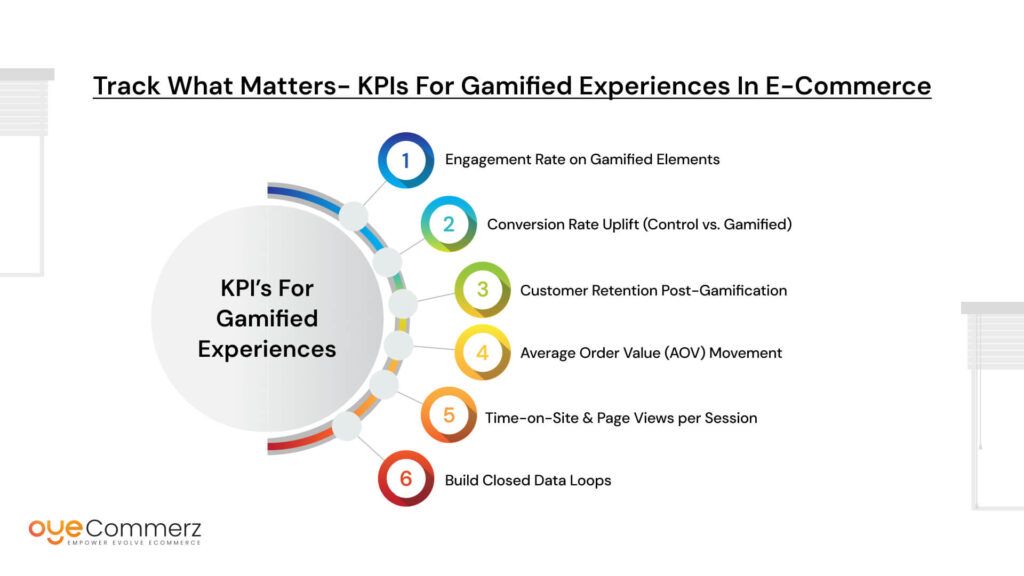
Introducing gamified experiences in e-commerce is only the beginning. For Shopify merchants, the real value lies in quantifying the results. It’s essential to track meaningful KPIs that demonstrate whether your gamification tactics are driving engagement, improving sales, or simply cluttering the user experience.
1. Engagement Rate on Gamified Elements
The first sign of a successful gamification strategy is user interaction. Measure Click-Through Rates (CTR) on interactive features like:
- Spin-to-win wheels
- Loyalty program signups
- Progress bars
- Quizzes or product matchers
Track these interactions via Shopify Analytics, Google Tag Manager (GTM), or app-specific dashboards. If CTRs are below industry benchmarks, the UX or value proposition might need refinement.
Insight: A high CTR means your gamified content is resonating with users and prompting action.
2. Conversion Rate Uplift (Control vs. Gamified)
It’s crucial to compare gamified versions of landing pages or product flows against control versions (non-gamified). This A/B testing helps isolate the impact of gamification on conversions.
Track:
- Product add-to-cart events
- Checkout starts
- Completed purchases
For instance, if a spin-to-win popup lifts conversions by 12% over the standard experience, you have hard proof that gamification is working.
3. Customer Retention Post-Gamification
Are customers coming back after interacting with gamified features? Retention is where long-term value is created. Metrics to monitor:
- Repeat purchase rate
- Loyalty point redemption frequency
- Email re-engagement from reward-based campaigns
Shopify’s Customer Reports and third-party CRM integrations like Klaviyo can help you track these trends. Higher retention means better customer satisfaction and lower acquisition costs.
4. Average Order Value (AOV) Movement
Gamified incentives should encourage users to spend more, whether through upsells, bundles, or reward thresholds. Watch for:
- AOV increases after introducing points-based loyalty
- Impact of progress bars (e.g., “Add $10 more to unlock free gift”)
If AOV climbs after gamification, you’ve unlocked a strong revenue lever.
5. Time-on-Site & Page Views per Session
Gamification extends engagement. Metrics to track:
- Session duration
- Pages viewed per visit
- Interaction depth (scroll percentage, feature usage)
Use Google Analytics 4 (GA4) to visualize these patterns. A healthy rise here indicates that gamified tools are making your site stickier, giving shoppers more reason to explore.
6. Build Closed Data Loops
Finally, always close the loop. Integrate all gamified tools with your analytics infrastructure:
- Use GTM to fire custom events for reward redemptions
- Link quizzes with CRM tags
- Trigger loyalty point emails via automation workflows
This enables iterative testing and optimization based on real-time user behavior.
By aligning your Shopify store’s gamified features with these KPIs, you ensure each interactive layer is not just engaging, but also driving measurable results. Track what matters, improve what doesn’t, and scale what performs.
Maintaining Relevance in Gamified E-Commerce Experiences
Introducing gamified experiences in e-commerce is a strong step toward boosting engagement, but the real challenge lies in maintaining long-term effectiveness. As user expectations evolve, so must your gamification strategy.
A static experience quickly loses its appeal. To keep your Shopify store’s gamified elements relevant, dynamic adjustments are key.
Rotate Gamification Elements Seasonally
Refreshing experiences based on time-sensitive themes ensures users stay curious and engaged:
- Holiday-themed spin wheels (e.g., Black Friday bonuses)
- Loyalty point resets or double-points promotions at quarter starts
- Seasonal quizzes for product discovery
This creates urgency while aligning with your promotional calendar.
Keep Rewards Exciting and Useful
Reward fatigue is real. If your incentives become predictable, they stop motivating action. Use short surveys, feedback forms, or post-purchase polls to gather input on:
- Preferred rewards (discounts vs. exclusive products)
- Redemption ease and value perception
Data-backed rewards retain meaning and inspire participation.
Educate Users on Gamification Benefits
If users don’t understand how to earn or redeem, your gamified features fail to convert. Clear onboarding, explainer popups, and tooltips can clarify:
- Tier benefits in loyalty programs
- Ways to earn points through actions
- Reward timelines and expirations
A/B Test for Optimal Performance
Use Shopify-integrated A/B testing tools or external platforms like Google Optimize to test:
- Trigger timing (on entry vs. exit intent)
- Messaging tone and CTAs
- Visual design of gamified widgets
Combine Gamification with Personalization
Layer gamified elements on top of personalized flows using tools like quizzes, segmentation logic, or email automation. A tailored experience drives stronger results than generic incentives.
Keeping gamification fresh ensures consistent engagement, better ROI, and ongoing customer delight.
Ready to Level Up Your Shopify Store with Smart Gamification?
At OyeCommerz, we specialize in Shopify services that don’t just look good, they perform. Whether you’re looking to implement spin wheels, loyalty programs, or intelligent quizzes, our team helps you build gamified experiences in e-commerce that truly convert. Let’s craft engagement that’s fun and functional, without turning off serious shoppers.
Partner with OyeCommerz and make every click count.
Contact to Migrate your Site to Shopify Now
Conclusion
Gamified experiences in e-commerce have evolved from a trend to a necessity in today’s competitive landscape. When thoughtfully implemented, these features boost user engagement, extend session duration, and drive stronger purchase intent, without undermining the professionalism of your brand.
Shopify’s ecosystem makes it easy to integrate these gamification tools. Whether it’s loyalty programs, interactive quizzes, or spin-to-win elements, merchants can seamlessly embed engaging features while maintaining full control over their store’s performance and appearance.
The key is balance. Overloading your site with gimmicks can alienate serious shoppers, but layering subtle, value-driven gamification can make the buying journey feel smoother, smarter, and more personalized.
Start by identifying your audience segments, choose gamified features that align with your goals, and monitor the right metrics to guide optimization. With the Shopify Services and the right strategy, gamification doesn’t just entertain, it converts and retains.
Frequently Asked Questions
Using game-like elements (points, rewards, challenges) to boost customer engagement, loyalty, and sales on online stores.
Yes, through features like badges, personalized recommendations, and rewards programs to encourage repeat purchases.
Gamification applies game mechanics to non-game contexts. Examples: loyalty points, spin-to-win wheels, progress bars.
1)Engagement, 2) Motivation, 3) Behavior change, 4) Loyalty and advocacy.
Yes, AI personalizes gamified experiences by tailoring rewards and challenges based on user behavior.



